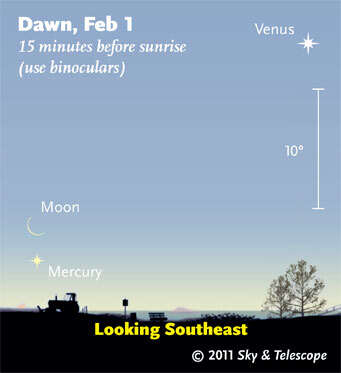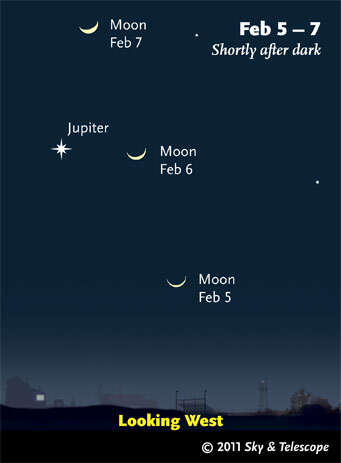芒果馅粽子的作品微盘:This Week's Sky at a Glance for January 28 – February 5
来源:百度文库 编辑:九乡新闻网 时间:2024/04/29 22:02:56
This Week's Sky at a Glance
Some daily events in the changing sky for January 28 – February 5.
by Alan M. MacRobert
 Earlyrisers can watch the waning Moon pass bright Venus, with Antares andScorpius looking on. (These scenes are drawn for the middle of NorthAmerica. European observers: move each Moon symbol a quarter of the waytoward the one for the previous date. The blue 10° scale is about thesize of your fist held at arm's length.)
Earlyrisers can watch the waning Moon pass bright Venus, with Antares andScorpius looking on. (These scenes are drawn for the middle of NorthAmerica. European observers: move each Moon symbol a quarter of the waytoward the one for the previous date. The blue 10° scale is about thesize of your fist held at arm's length.)
Sky & Telescope diagram
Friday, January 28
During dawn Saturday morning, the waning crescent Moon shines with bright Venus to its left, as shown above.
Is your sky dark enough for you to see the Great Andromeda Galaxy? It'sjust off the knee of the Andromeda stick figure. The brighter, sharperbottom-point of the Cassiopeia W points to it.
Jupiter's Great Red Spot transits Jupiter's central meridian around 8:23 p.m. Central Standard Time.
Saturday, January 29
As winter advances,the Big Dipper is working its way upward toward dominating the high skyof spring. Already the Dipper is standing on its handle in fine view inthe northeast after dinnertime.
During dawn Sunday morning, the thin waning Moon is below Venus, as shown above.
Sunday, January 30
Orion stands high in the southeast after dinnertime this week, with his diagonal belt pointing down toward brilliant Sirius.
Jupiter's Great Red Spot transits the planet's central meridian around 8:02 p.m. Pacific Standard Time.
 UseVenus as your starting point to try for Mercury and the very old Moonjust above the southeast horizon about 15 minutes before sunrise.Mercury and Venus are 30° apart. The farther south you are, the betteryour chances.
UseVenus as your starting point to try for Mercury and the very old Moonjust above the southeast horizon about 15 minutes before sunrise.Mercury and Venus are 30° apart. The farther south you are, the betteryour chances.
Sky & Telescope diagram
Monday, January 31
About 15 minutes beforeyour local sunrise timeTuesday morning, use binoculars to scan just above the southeasthorizon, far lower left of Venus, for the very thin crescent Moon withMercury below it — as shown here.
Tuesday, February 1
As the stars come outin late twilight this week, the Northern Cross of Cygnus plants itselfupright on the northwest horizon (as seen from the world's mid-northernlatitudes).
Wednesday, February 2
Bright Capella passesoverhead between 7 and 9 p.m., depending on how far east or west youlive in your time zone. How close Capella passes to your zenith dependson how far north or south you live. It goes exactly through your zenithif you're at latitude 46° north (Seattle; Montreal; central France).
New Moon (exact at 9:31 p.m. Eastern Standard Time).
Jupiter's Great Red Spot transits around 8:33 p.m. Eastern Standard Time.
Thursday, February 3
Sign of the times:With the coming of February, as early as 9 or 10 p.m. the Big Dipperclimbs to the same height in the northeast as Cassiopeia has descendedin the northwest.
And look midway between them for Polaris, the North Star.
Europa transits Jupiter's face from 5:28 to 8:12 p.m. Pacific StandardTime. Europa's shadow follows across Jupiter almost exactly two hoursbehind.
Friday, February 4
Sirius transits themeridian of the sky (i.e. is due south) around 9 or 10 p.m. now,depending on where you live east or west in your time zone. Sirius isthe brightest star in all the sky (after the Sun). The secondbrightest is far-southern Canopus. By coincidence, Canopus and Siriustransit at nearly the same time. If you live at least as far south asAtlanta, Phoenix, or Los Angeles, see if you can spot Canopus just abovethe south point on your horizon just 20 minutes before Sirius is duesouth.
Jupiter's Great Red Spot crosses the planet's central meridian around 7:12 p.m. Pacific Standard Time.
 Backin the evening sky, the waxing Moon passes Jupiter. (These scenes aredrawn for the middle of North America. European observers: move eachMoon symbol a quarter of the way toward the one for the previous date.For clarity, the Moon is shown three times actual size.)
Backin the evening sky, the waxing Moon passes Jupiter. (These scenes aredrawn for the middle of North America. European observers: move eachMoon symbol a quarter of the way toward the one for the previous date.For clarity, the Moon is shown three times actual size.)
Sky & Telescope diagram
Saturday, February 5
Jupiter and the waxingcrescent Moon inhabit the western sky during twilight and early eveningtonight and for the next few nights, as shown here.
Some daily events in the changing sky for January 28 – February 5.
by Alan M. MacRobert
Sky & Telescope diagram
Friday, January 28
During dawn Saturday morning, the waning crescent Moon shines with bright Venus to its left, as shown above.
Is your sky dark enough for you to see the Great Andromeda Galaxy? It'sjust off the knee of the Andromeda stick figure. The brighter, sharperbottom-point of the Cassiopeia W points to it.
Jupiter's Great Red Spot transits Jupiter's central meridian around 8:23 p.m. Central Standard Time.
Saturday, January 29
As winter advances,the Big Dipper is working its way upward toward dominating the high skyof spring. Already the Dipper is standing on its handle in fine view inthe northeast after dinnertime.
During dawn Sunday morning, the thin waning Moon is below Venus, as shown above.
Sunday, January 30
Orion stands high in the southeast after dinnertime this week, with his diagonal belt pointing down toward brilliant Sirius.
Jupiter's Great Red Spot transits the planet's central meridian around 8:02 p.m. Pacific Standard Time.
Sky & Telescope diagram
Monday, January 31
About 15 minutes beforeyour local sunrise timeTuesday morning, use binoculars to scan just above the southeasthorizon, far lower left of Venus, for the very thin crescent Moon withMercury below it — as shown here.
Tuesday, February 1
As the stars come outin late twilight this week, the Northern Cross of Cygnus plants itselfupright on the northwest horizon (as seen from the world's mid-northernlatitudes).
Wednesday, February 2
Bright Capella passesoverhead between 7 and 9 p.m., depending on how far east or west youlive in your time zone. How close Capella passes to your zenith dependson how far north or south you live. It goes exactly through your zenithif you're at latitude 46° north (Seattle; Montreal; central France).
New Moon (exact at 9:31 p.m. Eastern Standard Time).
Jupiter's Great Red Spot transits around 8:33 p.m. Eastern Standard Time.
Thursday, February 3
Sign of the times:With the coming of February, as early as 9 or 10 p.m. the Big Dipperclimbs to the same height in the northeast as Cassiopeia has descendedin the northwest.
And look midway between them for Polaris, the North Star.
Europa transits Jupiter's face from 5:28 to 8:12 p.m. Pacific StandardTime. Europa's shadow follows across Jupiter almost exactly two hoursbehind.
Friday, February 4
Sirius transits themeridian of the sky (i.e. is due south) around 9 or 10 p.m. now,depending on where you live east or west in your time zone. Sirius isthe brightest star in all the sky (after the Sun). The secondbrightest is far-southern Canopus. By coincidence, Canopus and Siriustransit at nearly the same time. If you live at least as far south asAtlanta, Phoenix, or Los Angeles, see if you can spot Canopus just abovethe south point on your horizon just 20 minutes before Sirius is duesouth.
Jupiter's Great Red Spot crosses the planet's central meridian around 7:12 p.m. Pacific Standard Time.
Sky & Telescope diagram
Saturday, February 5
Jupiter and the waxingcrescent Moon inhabit the western sky during twilight and early eveningtonight and for the next few nights, as shown here.
This Week's Sky at a Glance for January 28 – February 5
This Week's Sky at a Glance for December 31 – January 8
This Week's Sky at a Glance for January 7 – 15.
This Week's Sky at a Glance for January 14 – 22
This Week's Sky at a Glance for January 21 – 29
This Week's Sky at a Glance for February 4 – 12
This Week's Sky at a Glance for February 18 – 26.
This Week's Sky at a Glance for May 20 – 28
This Week's Sky at a Glance February 25 – March 5.
This Week's Sky at a Glance for March 4 – 12
This Week's Sky at a Glance for March 18 – 26
This Week's Sky at a Glance for March 25 – April 2.
This Week's Sky at a Glance for April 8 – 16
This Week's Sky at a Glance for April 15 – 23
This Week's Sky at a Glance for April 22 –30
This Week's Sky at a Glance for May 27 – June 4.
This Week's Sky at a Glance for June 3 – 6
This Week's Sky at a Glance for June 17 – 25
This Week's Sky at a Glance for July 29 – August 6
This Week's Sky at a Glance for September 8 – 17
This Week's Sky at a Glance for September 16 – 24
This Week's Sky at a Glance for June 24 - July 2
This Week's Sky at a Glance - SkyandTelescope.com
This Week's Sky at a Glance April 1 – 9